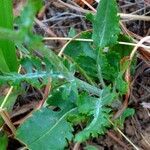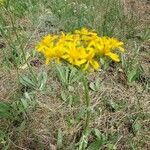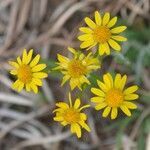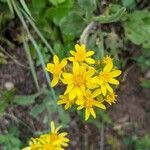Stout, single-stemmed, fibrous-rooted perennial 2.5–7 dm from a very short, erect caudex or crown, villous or hirsute with crisp loose hairs when young, commonly nearly glabrous by flowering time; lvs entire, denticulate, or sometimes irregularly dentate, the basal mostly oblanceolate or elliptic and short-petiolate, 8–25 cm (petiole included) × 1–5 cm; cauline lvs progressively reduced, becoming sessile; heads 5–25 in a rather congested infl, the terminal peduncle often shorter and thicker than the others; disk 8–17 mm wide; invol 5–10 mm, its bracts often minutely and irregularly black-tipped; rays 6–10 mm; achenes glabrous; 2n=40. Prairies and other open places; Sask., Minn., and Io., w. to B.C. and Calif. Apr.–June. Our plants are var. integerrimus.




